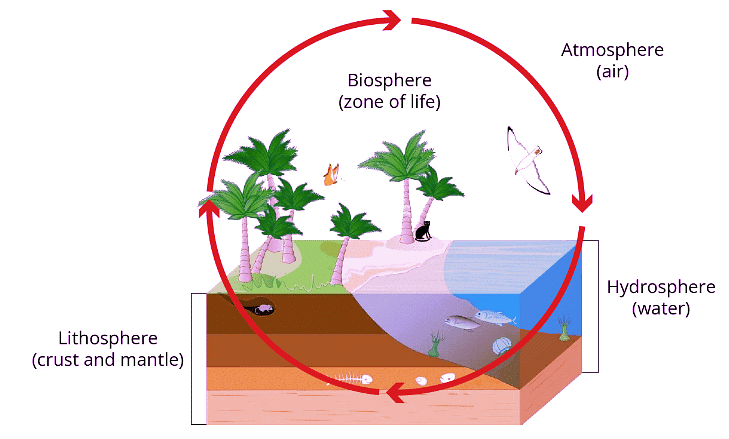Concept of Biosphere | Botany Optional for UPSC PDF Download
| Table of contents |

|
| What is the Biosphere? |

|
| Components of the Biosphere |

|
| Biosphere Resources |

|
| Importance of the Biosphere |

|
| Features of the Biosphere |

|
| Biosphere Examples |

|
The biosphere is a remarkable realm, teeming with diverse forms of life that range from minuscule single-celled organisms to majestic, large animals. This article delves into the fascinating world of the biosphere, exploring its definition, components, resources, importance, features, and examples. The biosphere is often referred to as the "zone of life," and it plays a pivotal role in sustaining all living organisms on Earth.

What is the Biosphere?
The biosphere, as the term suggests, is the sphere of the Earth where life flourishes. It constitutes the fourth sphere, where the Earth's lithosphere (land), hydrosphere (water), and atmosphere (air) converge to support various life forms. This concept was coined by Eduard Suess, who combined "bio" (life) with "sphere" (the shape of the Earth) to describe the areas on Earth inhabited by living organisms. The biosphere is a narrow yet indispensable zone on Earth's surface, serving as the exclusive habitat for life.
Components of the Biosphere
The biosphere encompasses a vast range of environments, from towering mountain peaks to the deepest ocean trenches, from scorching deserts to lush jungles. It comprises various essential elements, including air, soil, water, and rocks, both living and non-living. The biosphere comprises the following components:
Component | Description |
Lithosphere | Encompasses the Earth's rocks and soil. |
Atmosphere | Encompasses the Earth's gases, including carbon dioxide, nitrogen, and oxygen, in multiple layers. |
Hydrosphere | Includes all forms of water on Earth. |
These components collectively provide the fundamental necessities for life, such as air, water, land, energy, and suitable temperatures, enabling life to thrive across the biosphere.
Biosphere Resources
The biosphere offers an array of resources crucial for the sustenance of life, which can be categorized into two main types: biotic and abiotic resources. Biotic resources encompass living organisms like plants and animals, while abiotic resources consist of non-living elements like rocks and sunlight. These resources are essential for the survival and prosperity of various life forms within the biosphere.
Importance of the Biosphere
The biosphere plays an indispensable role in maintaining the balance of life on Earth. Even minor alterations in the biosphere can have significant impacts on the lives of organisms. The biosphere adapts to environmental changes, fosters favorable climatic conditions, and serves as a source of energy through the provision of food. Additionally, it plays a vital role in recycling nutrients such as oxygen and nitrogen. Furthermore, the biosphere serves as a source of food and raw materials for plants, animals, and humans.
Features of the Biosphere
The biosphere provides the necessary ecosystems for the survival of organisms and plays a crucial role in climate regulation. Living organisms must adapt to the specific climate conditions of their respective biospheres. It also serves as the primary source of food on Earth and safeguards areas for the protection of plant and animal life, known as biosphere reserves. These reserves help preserve regional biodiversity and maintain the ecological balance.
Biosphere Examples
The biosphere encompasses both land and air and defines the region where life exists on, above, and below the Earth's surface. It is often referred to as the ecosphere and comprises the lithosphere, a portion of the atmosphere, and the hydrosphere. The biosphere provides essential resources to humans, enabling us to transform and shape the physical world to meet our needs. For instance, soil serves as the foundation for agriculture, and rivers provide water for our survival.
Conclusion
In conclusion, the biosphere is the vital, narrow zone on Earth's surface where land, water, and air harmoniously interact to support life. This intricate system encompasses biotic and abiotic resources and is divided into distinct areas called biomes. Maintaining equilibrium among the elements of the biosphere is of utmost importance, and this can be achieved through various means, including biodiversity conservation, the establishment of national parks, environmental impact assessments, afforestation, and the adoption of Sustainable Development Goals (SDGs). The biosphere is not just the zone of life; it is the cradle of life on our planet, and its conservation is paramount for the well-being of all living creatures.
|
179 videos|143 docs
|
FAQs on Concept of Biosphere - Botany Optional for UPSC
| 1. What is the Biosphere? |  |
| 2. What are the components of the Biosphere? |  |
| 3. What are some examples of the Biosphere? |  |
| 4. Why is the Biosphere important? |  |
| 5. What are the features of the Biosphere? |  |



















